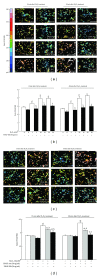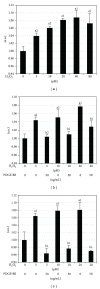PDGF suppresses oxidative stress induced Ca2+ overload and calpain activation in neurons
- PMID: 24454980
- PMCID: PMC3886591
- DOI: 10.1155/2013/367206
PDGF suppresses oxidative stress induced Ca2+ overload and calpain activation in neurons
Abstract
Oxidative stress is crucially involved in the pathogenesis of neurological diseases such as stroke and degenerative diseases. We previously demonstrated that platelet-derived growth factors (PDGFs) protected neurons from H2O2-induced oxidative stress and indicated the involvement of PI3K-Akt and MAP kinases as an underlying mechanism. Ca(2+) overload has been shown to mediate the neurotoxic effects of oxidative stress and excitotoxicity. We examined the effects of PDGFs on H2O2-induced Ca(2+) overload in primary cultured neurons to further clarify their neuroprotective mechanism. H2O2-induced Ca(2+) overload in neurons in a dose-dependent manner, while pretreating neurons with PDGF-BB for 24 hours largely suppressed it. In a comparative study, the suppressive effects of PDGF-BB were more potent than those of PDGF-AA. We then evaluated calpain activation, which was induced by Ca(2+) overload and mediated both apoptotic and nonapoptotic cell death. H2O2-induced calpain activation in neurons in a dose-dependent manner. Pretreatment of PDGF-BB completely blocked H2O2-induced calpain activation. To the best of our knowledge, the present study is the first to demonstrate the mechanism underlying the neuroprotective effects of PDGF against oxidative stress via the suppression of Ca(2+) overload and inactivation of calpain and suggests that PDGF-BB may be a potential therapeutic target of neurological diseases.
Figures


References
-
- Sayre LM, Perry G, Smith MA. Oxidative stress and neurotoxicity. Chemical Research in Toxicology. 2008;21(1):172–188. - PubMed
-
- Krieger C, Duchen MR. Mitochondria, Ca2+ and neurodegenerative disease. European Journal of Pharmacology. 2002;447(2-3):177–188. - PubMed
-
- Orrenius S, Zhivotovsky B, Nicotera P. Regulation of cell death: the calcium-apoptosis link. Nature Reviews Molecular Cell Biology. 2003;4(7):552–565. - PubMed
Publication types
MeSH terms
Substances
LinkOut - more resources
Full Text Sources
Other Literature Sources
Miscellaneous

